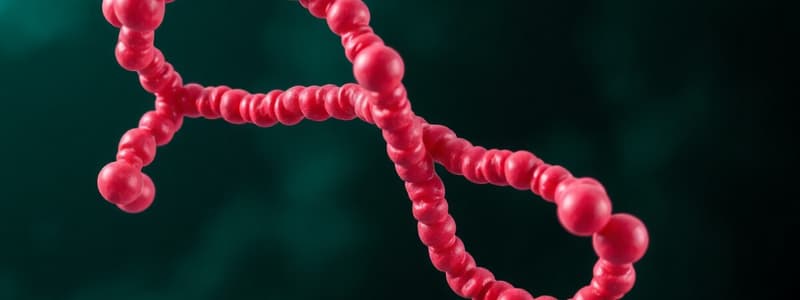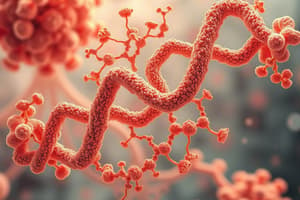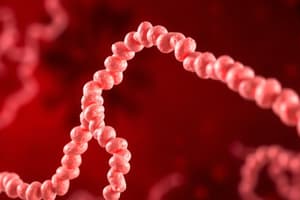Podcast
Questions and Answers
How do antibodies achieve specificity in recognizing specific epitopes on an antigen?
How do antibodies achieve specificity in recognizing specific epitopes on an antigen?
- Through interactions with the constant regions of the heavy chains, which vary greatly between antibodies.
- Via the hinge region that allows flexibility to accommodate different antigen shapes.
- Through the process of somatic hypermutation within the constant regions, altering the antibody's general affinity over time.
- By using antigen binding sites on the variable regions of the light and heavy chains, particularly the hypervariable regions (CDR1-3). (correct)
What is the primary role of the hinge region in IgG, IgD, and IgA antibodies?
What is the primary role of the hinge region in IgG, IgD, and IgA antibodies?
- To facilitate complement activation.
- To mediate interactions with immune cells via Fc receptors.
- To provide structural support for the constant region.
- To enable flexibility, allowing the antibody to bind to epitopes at varying angles and distances. (correct)
How do RSSs (recombination signal sequences) and RAG (recombination-activating genes) contribute to the diversity of B-cell receptors (BCRs) and antibodies?
How do RSSs (recombination signal sequences) and RAG (recombination-activating genes) contribute to the diversity of B-cell receptors (BCRs) and antibodies?
- RSSs promote somatic hypermutation in mature B cells, and RAG genes enhance this process in the germinal center.
- RSSs directly encode the variable regions of antibodies, while RAG genes modify these regions post-transcriptionally.
- RSSs inhibit gene transcription outside of the variable region, while RAG genes enhance transcription within the variable region.
- RSSs guide somatic recombination by flanking gene segments, and RAG genes mediate the cutting and joining of DNA segments. (correct)
During the generation of junctional diversity, which enzyme is responsible for the addition of N-nucleotides?
During the generation of junctional diversity, which enzyme is responsible for the addition of N-nucleotides?
Which mechanism of antibody-mediated combatting of infection, enhances phagocytosis by coating the pathogen to promote recognition and ingestion by phagocytes?
Which mechanism of antibody-mediated combatting of infection, enhances phagocytosis by coating the pathogen to promote recognition and ingestion by phagocytes?
Which of the following is the primary distinction between the roles of IgG1 and IgG4?
Which of the following is the primary distinction between the roles of IgG1 and IgG4?
If a patient lacks the ability to produce the enzyme AID, which of the following immune processes would be directly impaired?
If a patient lacks the ability to produce the enzyme AID, which of the following immune processes would be directly impaired?
A researcher is studying the immune response in mucosal tissues. Which antibody form would they most likely find in abundance in these areas?
A researcher is studying the immune response in mucosal tissues. Which antibody form would they most likely find in abundance in these areas?
How does alternative splicing contribute to B-cell function?
How does alternative splicing contribute to B-cell function?
Which step in the antibody production process is both reversible and regulated, allowing for dynamic adjustments in the immune response?
Which step in the antibody production process is both reversible and regulated, allowing for dynamic adjustments in the immune response?
What is the significance of junctional diversity in antibody production?
What is the significance of junctional diversity in antibody production?
Considering their effector functions, which antibody would be most effective against a systemic bacterial infection?
Considering their effector functions, which antibody would be most effective against a systemic bacterial infection?
During an infection, if a B cell initially produces IgM, what mechanism allows it to later produce IgG1 antibodies specific to the same antigen?
During an infection, if a B cell initially produces IgM, what mechanism allows it to later produce IgG1 antibodies specific to the same antigen?
Which antibody class is MOST effective at directly triggering the classical complement pathway?
Which antibody class is MOST effective at directly triggering the classical complement pathway?
Which process is irreversible once it occurs in a B cell?
Which process is irreversible once it occurs in a B cell?
Flashcards
Epitopes
Epitopes
Specific regions on an antigen recognized by antibodies.
Hinge region of antibodies
Hinge region of antibodies
Flexible part of IgG, IgD, and IgA classes allowing movement.
Hypervariable regions
Hypervariable regions
Regions in antibodies that determine specificity for epitopes.
RAG genes
RAG genes
Signup and view all the flashcards
Junctional diversity
Junctional diversity
Signup and view all the flashcards
IgA
IgA
Signup and view all the flashcards
IgM
IgM
Signup and view all the flashcards
IgG subclass functions
IgG subclass functions
Signup and view all the flashcards
Somatic hypermutation
Somatic hypermutation
Signup and view all the flashcards
Antibody class switching
Antibody class switching
Signup and view all the flashcards
BCR vs. Antibody
BCR vs. Antibody
Signup and view all the flashcards
Reversible antibody production stages
Reversible antibody production stages
Signup and view all the flashcards
Irreversible antibody production stages
Irreversible antibody production stages
Signup and view all the flashcards
Activation-induced cytidine deaminase (AID)
Activation-induced cytidine deaminase (AID)
Signup and view all the flashcards
Multimeric antibodies
Multimeric antibodies
Signup and view all the flashcards
Study Notes
Antibody Recognition of Epitopes
- Antibodies recognize specific epitopes, localized regions on antigens that trigger immune responses.
Antibody Hinge Region
- The hinge region is found only in IgG, IgD, and IgA antibodies.
- Its function isn't specified.
Hypervariable Regions (HV1-HV3 or CDR1-3)
- The antibody's antigen-binding site, in the variable regions of light and heavy chains, determines epitope recognition.
- Amino acid sequences in these regions dictate specificity.
- Diversity in these regions creates different antibody specificities.
RSSs and RAG Genes
- RSSs (recombination signal sequences) guide somatic recombination of gene segments.
- RAG (recombination-activating genes) are crucial in B and T cell development, orchestrating this process.
Junctional Diversity
- Junctional diversity creates further antibody diversity beyond the gene segments.
- The RAG complex cleaves RSSs, creating DNA hairpins that RAG opens.
- P-nucleotides form from nicks in the DNA strands.
- TdT adds N-nucleotides, and exonucleases remove unpaired nucleotides.
- Coding ends are synthesized and joined, creating varied antibody combinations.
- Not all junctional diversity events yield a functional BCR.
Antibody Mechanisms Against Infections
- Antibodies combat infections through several mechanisms, including:
- Classical pathway (complement activation)
- Neutralization (preventing pathogen binding)
- Opsonization (enhancing phagocytosis)
Antibody Classes and Functions
-
IgG, IgA are further divided into subclasses (IgG1-4, IgA1, IgA2).
-
IgM exists as a membrane-bound monomer or secreted pentamer.
-
IgA exists as a monomer or dimer (secreted to mucosal surfaces).
-
Each class has different roles in immunity, including neutralization, opsonization, complement activation, and transport.
-
Specific roles for different Antibody classes:
- IgM: Neutralization, complement activation, transport.
- IgG1: Neutralization, opsonization, NK cell activation, mast cell sensitization, complement activation, placental transport.
- IgG2: Neutralization, complement activation, placental transport.
- IgG3: Neutralization, opsonization, NK cell activation, mast cell sensitization, complement activation, placental transport.
- IgG4: Neutralization, opsonization, placental transport.
- IgA: Neutralization, opsonization, complement activation, mucosal transport.
- IgE: Mast cell sensitization.
Antibody Forms
- IgM and IgA can form multimers.
Somatic Hypermutation
- Somatic hypermutation occurs after B-cell antigen activation.
- It targets the rearranged variable region gene segment.
- Activation-induced cytidine deaminase (AID) is the key enzyme.
- AID converts cytidine to uridine, which DNA repair enzymes alter.
- This process diversifies antibodies, enhancing affinity.
Antibody Class Switching
- Class switching involves recombination of specific DNA regions.
- IgM and IgD are initially produced.
- AID targets switch regions (e.g., Su, Sy1).
- DNA strands recombine to switch to other classes (e.g., IgG1).
B Cell Production of IgM vs. IgD
- B cells initially produce both IgM and IgD. (Co-expression)
BCR vs. Antibody Production
- Alternative splicing determines the membrane-bound (BCR) or secreted (antibody) form.
Reversible vs. Irreversible Antibody Production Stages
- V-region assembly, junctional diversity, and transcriptional controlling elements are irreversible.
- Antibody production's steps involving membrane Ig to secreted antibody and somatic hypermutation are regulated and reversible.
Studying That Suits You
Use AI to generate personalized quizzes and flashcards to suit your learning preferences.




